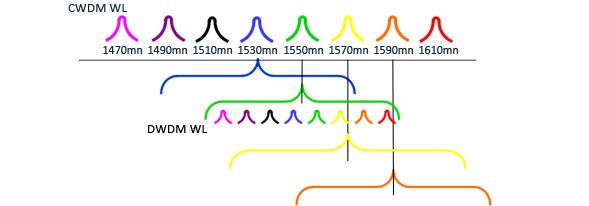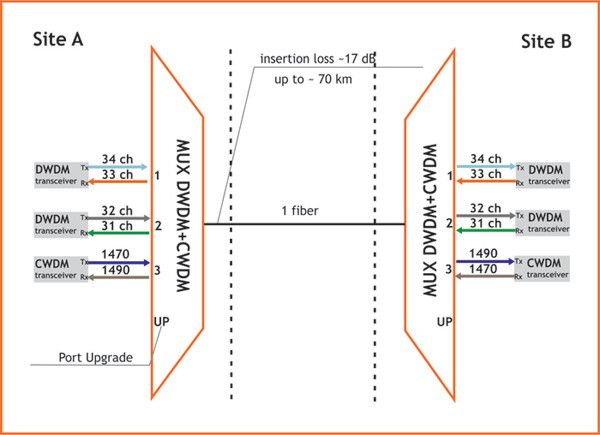How to configure tunable DWDM-XFP-C on ASR9010
Currently we have a CRS-3 router connected to a 7609 router throu...
What you need to know about 100G
What you need to know about 100G Transporting data was up to 1...
Compatibility guide for Fiber Optic Modules
Compatiblebrand Model TinoutProduct type Product descr...
SFP Definition from Tinout
(Small Form-factor Pluggable) A small transceiver that plugs into the SFP port of a network switch and connects to Fibre Channel and Gigabit Ethernet (GbE) optical fiber cables at the other end. Superseding the GBIC transceiver, SFP modules are also called "mini-GBIC" due to their smaller size. By choosing the appropriate SFP module, the same electrical port on the switch can connect to fibers of different types (multimode or singlemode) and different wavelengths. If the fiber is upgraded,
Hybrid CWDM+DWDM
CWDM + DWDM hybrid systems are used to empower CWDM systems by integrating CWDM and DWDM equipment.
The creation of such systems helps to construct metropolitan area networks with a bandwidth of up to 10 Gbit/s per channel.
The hardware complex of a hybrid multiplexing system allows to implement up to 40 duplex channels based on DWDM technology and up to 8 duplex channels
based on CWDM technology in a single optical fiber.
The creation of hybrid multiplexers through the cross-connections of separate CWDM and DWDM devices provides high values of additional attenuations
(up to 1.5 dB, depending on connectors). This attenuation value is unacceptable when creating paths with length of over 40 kilometers.
We offer solutions that ensure a low value of additional attenuations (up to 0.5 dB) and successfully combine features of CWDM and DWDM technologies.
Since the physical fiber optic cabling is expensive to implement for each and every service separately, its capacity expansion using a Wavelength Division Multiplexing (WDM) is a necessity. WDM is a concept that describes combination of several streams of data/storage/video or voice on the same physical fiber-optic cable by using several wavelengths (frequencies) of light with each frequency carrying a different type of data.
There are two types of WDM architecture: Coarse Wavelength Division Multiplexing (CWDM) and Dense Wavelength Division Multiplexing (DWDM). CWDM systems typically provide 8 wavelengths, separated by 20nm, from 1470nm to 1610nm. In order to increase the number of wavelength, one can also use the 1310 nm window so the CWDM channels can be increased to 16. Some DWDM network systems provide up to 96 wavelengths, typically with no more than 0.4nm spacing, roughly over the C-band range of wavelengths.
The main advantage of CWDM is the cost of the optics which is typically 1/3rd of the cost of the equivalent DWDM optic. This difference in economic scale, the limited budget that many customers face, and typical initial requirements not to exceed 8 wavelengths, means that CWDM is a more popular entry point for many customers. With Tinout's WDM equipment, a customer can start with 8 CWDM wavelengths but then grow by introducing DWDM wavelengths into the mix, utilizing the existing fiber and maximizing return on investment.
By utilizing CWDM and DWDM network systems or the mixture of thereof, carriers and enterprises are able to transport services from 2Mbps up to 100Gbps of data.


System Capabilities:
joint transmission of up to 40 duplex channels implemented via DWDM and up to 8 duplex channels implemented via CWDM;
support of all transmission protocols;
transmission of various types of traffic at various rates.
Transmission Medium Features:
single optical fiber;
maximum route length of up to 70 km (depending on fiber-inserted attenuations);
maximum value of fiber-inserted attenuations of about 17 dB (depending on the number of implemented channels).






